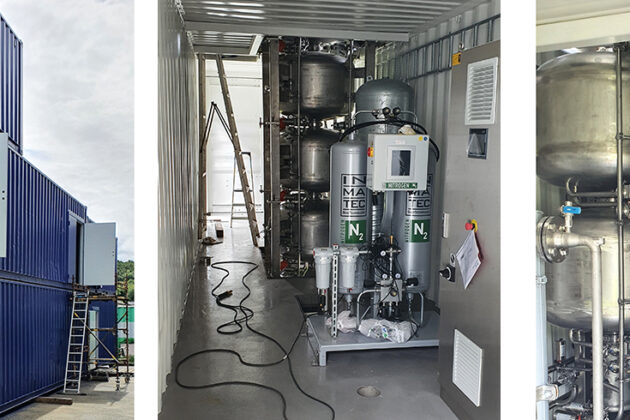Nitrogen gives promising results in hydrolysis process

Side-streams from industrial processing of herring, such as spines, heads and intestines contains beneficial proteins and marine fatty acids. Technological developments can help increase the quality of fat and protein products based on these parts.
Nofima researchers are collaborating with several companies developing technologies to ensure high-quality products based on industrial side-streams. One of these companies is NUAS Technology. The goal of NUAS Technology is to develop a new type of hydrolysis process that will provide better utilisation, better process control and higher quality in production of protein and lipid products from both marine and animal side-streams.
“Such collaborations allow manufacturers to benefit from our extensive knowledge of enzyme technology, for example, ensuring that the enzyme used is the best suited for the task at hand,” says researcher Diana Lindberg at Nofima.
Also, for many years, Nofima has been developing analytical methods that have resulted in an increasingly larger analysis platform. This analysis platform simplifies the process of, for example, verifying yield resulting from a selected process, of evaluating different qualitative aspects of both protein/peptide products and oils, and process optimisation.
“While manufacturers can use the knowledge to ensure that both product quality and yield is optimal, at Nofima we can learn more about opportunities with regards to new industrial technologies,” says Diana Lindberg.
With their background in the mechanical industry, the founders of NUAS Technology have a different approach than other companies currently working in the extraction of proteins and oils from side-streams from the marine food industry. This was the basis for choosing an entirely different process.
Enhanced control of the process
NUAS Technology has developed and patented a hydrolysis reactor comprising several chambers in a row, allows the hydrolysate to be transported through the chambers during processing. The difference with this process as opposed to a more traditional batch reactor lays in how the hydrolysate is stirred. Instead of using a batch reactor with mechanical stirring, nitrogen gas is pumped into the chamber to facilitate stirring.
“The intention is to simplify and improve on our earlier hydrolysis patent. Now we are able to process all types of materials, including fish, shellfish and chicken, both with and without bone content. The idea behind the process is to make it as gentle, controllable and energy efficient as possible. Thus, gravity is used to transport the hydrolysate from one chamber to the next,” says Johan Wemundstad, one of the two owners and founders of NUAS.
Promising results from fatty acids
Marine fatty acids and proteins are also extracted from herring side-streams today, although many of the existing technological solutions do not remove the air, and hence oxygen, which means that the oil extracted from the fatty acids can oxidise. As the method that NUAS has developed utilizes nitrogen for stirring, it also removes oxygen from the mixture which results in reduced risk of oxidisation.
As a part of a larger project led by NUAS Technology, they got in touch with Nofima researcher Diana Lindberg in order to help with the following:
– evaluate the effectiveness of the enzyme within this technology
– analyse the quality of the protein product
– evaluate if there are any changes in oxidisation of protein and oil.
Thus far, Diana and her colleagues have conducted the preliminary study. Here, they have compared the effects on products and processing using nitrogen stirring as compared to using a traditional batch reactor in hydrolysis of herring and herring side-streams.
“We were very interested in getting more information about to if, and if so, to which extent the bubble process would cause the activity of the enzymes that split the proteins, the so-called proteases, to be reduced. However, thus far, there is nothing to suggest this. The introductory tests also suggest that the marine fatty acids EPA and DHA maintain a higher quality in nitrogen hydrolysis due to less oxidisation” explains Diana Lindberg.
The next stage is to compare the lab data with the analysis data from the trials at the NUAS pilot facility.
The results from the collaboration with Nofima has verified that our technology can indeed result in the improved product quality that we believed when developing it. For our customers, analyses undertaken by an authorised third party are important. Also, we have received information that provides us with a solid basis for further optimisation of the process at the pilot plant,” concludes Johan Wemundstad.
Contact person
Research areas
Bioprocessing
Topics
Residual raw materials
